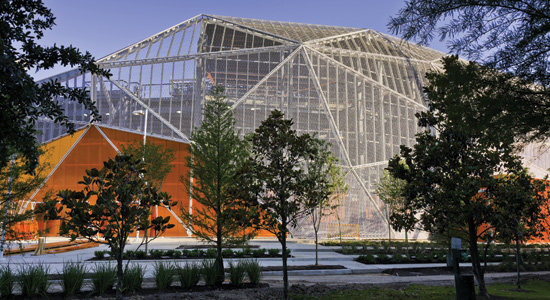Expanded Metal Mesh in Architecture
Learning Objectives:
- Identify and recognize the characteristics of expanded metal mesh for use in architectural applications.
- Investigate the design potential and innovative opportunities to use expanded metal mesh in different design applications.
- Assess the functional contributions of expanded metal mesh as it may contribute to green and sustainable design.
- Specify expanded metal mesh in a variety of buildings and formulate appropriate selections related to specific applications.
Credits:
Designers routinely use interior and exterior surface materials to provide a visual and sensory experience of a building. Smooth, pristine surfaces create an obviously different design experience than a textured one. Similarly, surfaces that can bend or flow to provide a more threedimensional experience create buildings with a very different design sense than flat rectilinear structures. Materials that allow air and light to penetrate them provide other design opportunities compared to opaque materials. For each of these design conditions, there is one material that can actually address them all and has seen a surging popularity in both interior and exterior applications. This material is known generically as expanded metal mesh and is a well-known, time-proven material in many industrial and heavy-usage building conditions. It has also recently been discovered as a very f lexible, affordable, and customizable material that can create a wide variety of appearances and functions that create exciting design possibilities for buildings of all types.
Characteristics of Expanded Metal Mesh
As the name implies, expanded metal mesh is fabricated from various types and thicknesses of metal. The “expanded” part means that it is different, however, from punched or perforated metal. If sheet or coil metal has a pattern of holes cut or punched into it, creating loose pieces of scrap that fall from those holes, then that defines punched or perforated metal. By contrast expanded metal mesh is fabricated from sheet or coil metal that is slit and stretched into a nonraveling unit of uniform-size diamond-shaped openings. This process of slitting and stretching means not only that waste or scrap is eliminated, it means that in certain cases a 4-foot by 10-foot piece of metal is actually stretched into a mesh that measures on the order of 12 feet by 10 feet when processed. As such, the final product is inherently very efficient in terms of material usage which translates into great cost-effectiveness.
Manufacturing
The manufacturing process for expanded metal mesh was first patented in Hartlepool, UK, in the 1880s, and despite the amount of time that has elapsed since then, it’s current manufacture remains true to the original idea.
The process is simple but incredibly effective. Expanded metal is formed in an expanding press. Either stock size or custom size metal sheet or coil stock is fed into the expanding machine. Each machine is fitted with a unique “knife” dedicated to a particular pattern. The machines are then programmed or manually controlled to ensure that the metal is slit, sheared, and then stretched in a single process creating the apertures and therefore expanding the metal. The base metal is simultaneously slit and cold-formed, which expands the slits into diamond-shaped openings of uniform size and regularity. The diamonds typically range from about 1/8 inch to 3 inches (3 to 76 mm) wide and ¼ inch to 8 inches (6 to 200 mm) long. Custom knives can be manufactured to create different design patterns of openings. The resulting mesh is then either cut into sheets or wound onto coils ready for shipping or further processing.
The specific metal used to fabricate the expanded metal mesh can come in a range of metal types and thicknesses. Common choices include carbon steel, aluminum, and stainless steel. However, it is also possible to find manufacturers that produce expanded mesh from specialty metals such as brass, weathering steel, copper, titanium, nickel based alloys, and even some types of plastic. The combination of metal type and thickness helps determine not only the final appearance of the expanded metal mesh, it also plays directly into the overall strength, rigidity, and durability of the final product when installed in specific settings.
The manufacturing process and material selections allow for great versatility in the types of expanded metal mesh that are possible and available. The opening sizes or apertures can be made in a full range of dimensions from very small micro mesh openings to very large openings. A variety of depths are also possible to create a rather flat mesh surface or a very threedimensional surface with considerable depth between the front and rear of the mesh. These variations in openings and depth facilitate the free flow of air, fluid, or light where required at the degree or intensity desired or required.
 |
Expanded metal mesh provides a unifying architectural enclosure that allows both light and air to penetrate as determined by design. Photo by G. Lyon Photography, Inc., courtesy of AMICO |









